Active Aging: Unveiling the WHO Active Aging Framework
As the world faces a rapidly aging population, the need for effective health policies and frameworks to promote healthy aging becomes increasingly critical. The World Health Organization (WHO) has developed a comprehensive framework focused on active aging, aiming to enhance the well-being of older adults worldwide. In this article, we will delve into the WHO Active Aging Framework, explore its components, and understand how it contributes to longevity and overall well-being among the elderly.
Understanding Active Aging
Active aging is a holistic approach that emphasizes the importance of maintaining health, independence, and quality of life as individuals age. It recognizes that aging is not just a biological process but also a social and economic one. The WHO framework advocates for policies and practices that enable older individuals to live fulfilling lives, engage in their communities, and contribute to society.
The WHO Active Aging Framework: Key Components
The WHO Active Aging Framework is built upon several key components that guide countries in developing strategies for elderly care. These components include:
- Health: Promoting physical and mental health to enhance longevity and quality of life.
- Participation: Encouraging social engagement and participation in community activities.
- Security: Ensuring that older adults have access to necessary resources and services for their well-being.
- Independence: Supporting autonomy and the ability to live independently.
The Importance of Healthy Aging
Healthy aging is at the heart of the WHO Active Aging Framework. It encompasses not just the absence of disease but also the presence of physical, mental, and social well-being. By focusing on healthy aging, the framework aims to:
- Reduce the incidence of age-related diseases.
- Enhance the physical and cognitive capacities of older adults.
- Promote mental health and emotional well-being.
- Encourage active participation in social and economic life.
Strategies for Implementing the WHO Framework
To effectively implement the WHO Active Aging Framework, governments and organizations should consider the following strategies:
- Develop Comprehensive Policies: Create health policies that address the diverse needs of the aging population.
- Promote Lifelong Learning: Encourage continuous education and skill development among older adults.
- Enhance Accessibility: Improve accessibility in public spaces, transportation, and healthcare services.
- Foster Community Engagement: Create opportunities for older adults to participate in community activities and decision-making.
- Support Caregivers: Provide resources and training for caregivers to enhance the quality of elderly care.
Troubleshooting Common Challenges
While the WHO Active Aging Framework offers a promising approach to elderly care, several challenges may arise during its implementation. Here are some common challenges and potential solutions:
Challenge 1: Lack of Awareness
Many individuals and policymakers may not be familiar with the concepts of active aging and healthy aging.
Solution: Conduct awareness campaigns to educate the public and stakeholders about the benefits of active aging.
Challenge 2: Insufficient Funding
Implementing comprehensive health policies often requires significant financial investment.
Solution: Advocate for increased funding from government and private sectors to support active aging initiatives.
Challenge 3: Fragmented Services
Older adults may struggle to navigate the various services available to them.
Solution: Develop integrated service models that provide a seamless experience for older adults seeking care and support.
The Role of Global Health Initiatives
The WHO Active Aging Framework aligns with broader global health initiatives aimed at improving health outcomes for the elderly. Various organizations and governments are working together to:
- Share best practices and successful case studies.
- Encourage research on aging-related issues.
- Promote collaboration among sectors, including health, education, and social services.
For more information on global health initiatives related to aging, you can visit the WHO’s website.
Conclusion: A Call to Action
The aging population presents both challenges and opportunities for societies around the world. The WHO Active Aging Framework serves as a valuable tool for promoting active aging, healthy aging, and overall well-being among older adults. By implementing effective health policies and strategies, we can support the elderly in leading fulfilling lives and contributing to their communities.
It is essential for governments, organizations, and individuals to recognize the importance of active aging and work collaboratively towards creating an inclusive environment for the aging population. Let us take action now to ensure that our elderly care systems reflect the principles of the WHO framework, fostering longevity, health, and well-being for all.
For further reading on active aging and related topics, explore our internal resources that provide insights into best practices and ongoing initiatives in elderly care.
This article is in the category Health and created by AgeGracefullyCare Team
